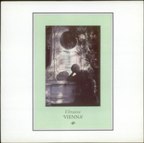Whenever there is talk about songs that were kept off number one in the chart, almost always, the most famous is generally cited as Vienna by Ultravox, which was kept off the top by Joe Dolce’s Shaddup You Face. There have been worst crimes, but novelty records have a tendency to do that, because, by definition, that’s what they are and people generally love novelty. When Midge Ure, Ultavox’s lead singer, was asked recently if it still irked him, he replied, “No. People tend to forget that John Lennon was shot at the same time and Imagine and Woman went to Number One as well. It was such a bizarre scenario where you went from the sublime to the ridiculous and both kept us off number One. But the fact that Vienna stayed where it did for such a long time and it outsold both records – it elevated the band from cult status, playing the college unions, up to where we could play Crystal Palace or Wembley, which was great.”
Ultravox began in the mid-seventies with John Foxx as their lead singer, but when Foxx left in 1979 and they were dropped by their record company, Island, the future looked bleak. However the arrival of Midge Ure heralded an unlikely revival of fortunes. Ure had been a member of the chart-topping Scottish teeny-bop outfit Slik, before teaming up with Rusty Egan and the former Sex Pistol Glen Matlock in The Rich Kids. He joined Ultravox in the spring of 1979 and they signed a new deal with Chrysalis records and the hits started coming beginning with Sleepwalk and Passing Strangers.
Vienna was co-written by all members of the band who were, in addition to Ure, Chris Cross, Billie Currie and Warren Cann. Cann, the band’s drummer recalled, “The song came together very quickly. I had a drum machine/synth pad pattern in mind that I’d wanted to do. I rolled it out saying to the band, ‘What about this, then?’ and began the ‘Vienna’ rhythm.”
Billie Currie remembered in an interview with Mojo magazine, “We were all being very arty, discussing the composer Max Reger, and Midge walked up and said in his Glaswegian accent, ‘This means nothing to me,’ and turned away. When we came in he’d put down this operatic-type chorus using that very phrase.” Cann continued, “A couple more verses were prepared by Ure and the song was ready.” The band settled into RAK, Mickie Most’s London studio, with the German producer Conny Plank, who had worked extensively with Kraftwerk. “It all clicked in a few hours and we ironed out the rough spots the next day,” said Cann, “Except for finessing the middle ‘solo’ section of the song once we were in the studio, that was basically it. A hit a day keeps the dole away. We knew it was the musical high point of the album and made it the title track. It was the song that best represented what we were trying to do. We were determined that it would be our third single and fought with Chrysalis over it; naturally, they thought it was far too long at six minutes, too weird for a Top 30 chart hit, and too depressing and too slow. Other than that, they liked it.” Midge recalled in Rolling Stone magazine, “I lied to the papers about it at the time. I wrote a song about a holiday romance, but in this very dark, ominous surrounding.”
The accompanying video, which was a mini epic, was predominantly filmed in London’s Covent Garden and included a tarantula crawling across the director, Julien Temple’s, face. For some, it’s reminiscent of the Vienna Secessionists from the 1949 film The Third Man directed by Carol Reed, who later went on to direct Oliver. There were bits done in Vienna and “We did it on the cheap,” recalled Cann. “There was just us and our trusty cameraman, Nick. We took an early morning flight to Vienna, ran round like loonies in and out of taxis as we filmed, and soon discovered that, due to it being the winter off-season, many of the splendid places we’d been counting upon filming were either shut for redecorating or covered with webs of scaffolding. We finished up in the cemetery for the shots with the statue which had been used for the single’s cover.” The gravestone is that of Carl Schweighofer who was a famous Austrian piano maker and is located on the Zentralfriedhof cemetery in Vienna. “We did the sunset shot, and then dashed back to London to start editing.”
Vienna was back in the chart in 1993 where it reached number 13. The reason being it was re-issued to promote Ultravox’s new greatest hits package which also included many of Midge’s solo singles and B-sides.
In December 2012, BBC Radio 2 polled their listeners to find the greatest number two hit and apparently a “panel of experts!” compiled the list which saw Vienna top their chart. Midge said, “We are extremely pleased and very humbled to have been given this honorary number one, especially knowing the outstanding records which were also in the running.” The other songs in the top five were; Fairytale of New York at five, Don McLean’s American Pie and three, James’ Sit Down at four and The Stranglers’ Golden Brown at five.
